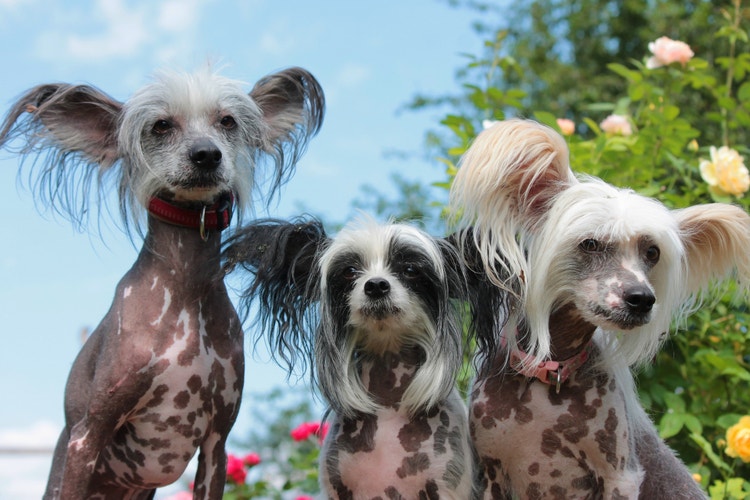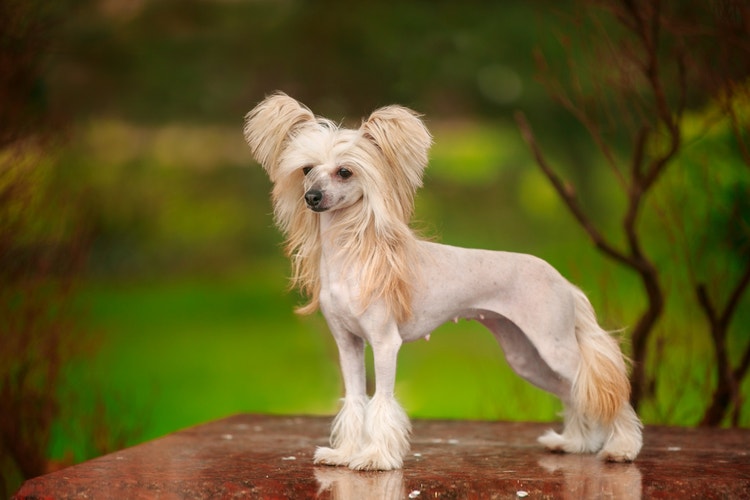

Chinese Crested


Where Are Chinese Crested Dogs From?
Despite their name, the Chinese Crested breed most likely descended from the African Hairless Dog. Upon making their way to China, they were bred to be more compact, resembling the version we know and love today.
Explorers found similar breeds in Mexico, Central America, and South America in the 1500s, as well as examples in Africa and Asia as far back as the 18th Century.
The breed was registered by the American Kennel Club in 1991.
Caring for a Chinese Crested Dog
What Kind of Diet Does a Chinese Crested Dog Need?
What Kind of Diet Does a Chinese Crested Dog Need?
Chinese Crested dogs should be fed puppy food for their first 12 months, since growth is rapid early on and high caloric intake ensures proper bone and joint development.
This breed is prone to dental disease, so a dry food diet will help to decrease tarter build-up.
How Much Grooming Does a Chinese Crested Dog Need?
How Much Grooming Does a Chinese Crested Dog Need?
Hairless variations don’t require much grooming, aside from a monthly bath. However, they are prone to acne and dry skin. If you notice excessive itching or redness, consult with your veterinarian.
Powderpuff dogs will require far more grooming, due to their long, fluffy hair. They will need to be brushed daily to keep hair from tangling and knotting.
Are Chinese Crested Dogs Healthy?
Are Chinese Crested Dogs Healthy?
The Chinese Crested breed is relatively healthy, unlike many other breeds of their size. They are, however, prone to a few congenital diseases.
They need to be screened for multiple ocular diseases and have a yearly check-up with a veterinarian to ensure their happiness and health. Their skin is extremely soft and smooth, which requires daily maintenance in relation to their susceptibility to sunburn, acne, and dryness. A sunscreen approved by your veterinarian should be applied if they are spending time in direct sunlight.
The breed has a life span of 12 to 16 years of age.
Chinese Crested dogs are predisposed to: keratoconjunctivitis sicca (KCS), retinal atrophy, lens luxation, glaucoma, patellar luxation, dystocia, sunburn, acne, dental diseases, allergies, and autoimmune diseases.
How Much Training Does a Chinese Crested Dog Need?
How Much Training Does a Chinese Crested Dog Need?
The Chinese Crested is a highly intelligent and easily trainable breed. However, they can be stubborn, so they will need a gentle (but persistent) trainer.
Socialization at a young age is important, since they can be timid by nature. Training should start at 6 to 8 weeks of age. Until your pet is fully vaccinated, they should not spend time at dog parks or playgrounds.
The breed loves playing and interacting with family, especially children. They also enjoy competition and agility training.
How Much Exercise Does a Chinese Crested Dog Need?
How Much Exercise Does a Chinese Crested Dog Need?
This is not an energetic breed, so a short 10-minute walk twice a day is enough to keep them in shape. Despite this, they still love to play and run around, so indoor activities are a great way to exercise and keep them engaged. These little dogs will make great couch potatoes if you let them.
What Are the Physical Characteristics of a Chinese Crested Dog?
Chinese Crested Dog Facts
Other Breeds to Explore
References
- Morris, Desmond. Dogs: The Ultimate Dictionary of Over 1,000 Dog Breeds. Trafalgar Square, 2002.
- American Kennel Club. The Complete Dog Book. Random House Digital, Inc., 2006.
- Wilcox, Bonnie and Chris Walkowicz. The Atlas of Dog Breeds of the World. T.F.H Publications, Inc., 1995.


